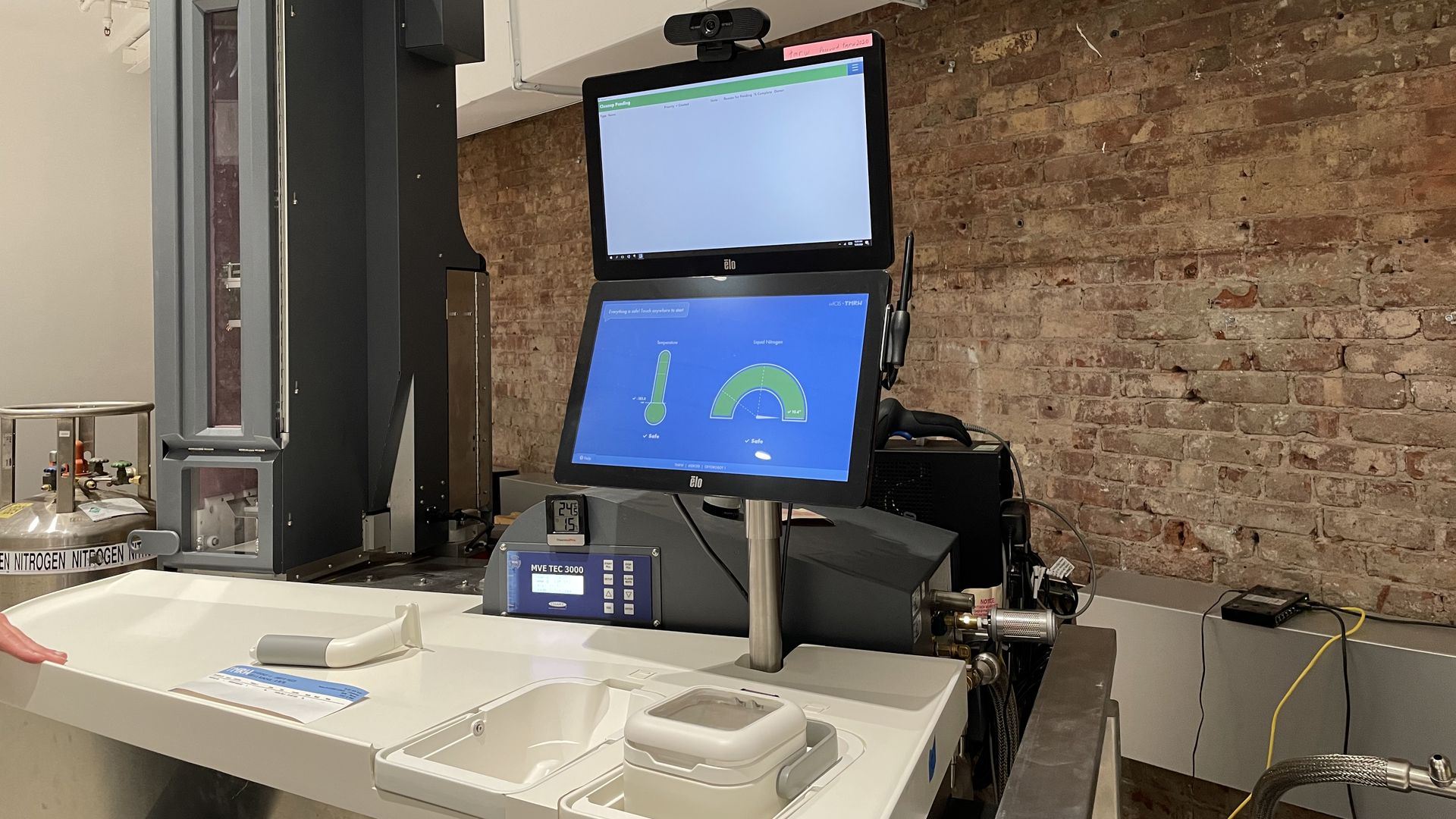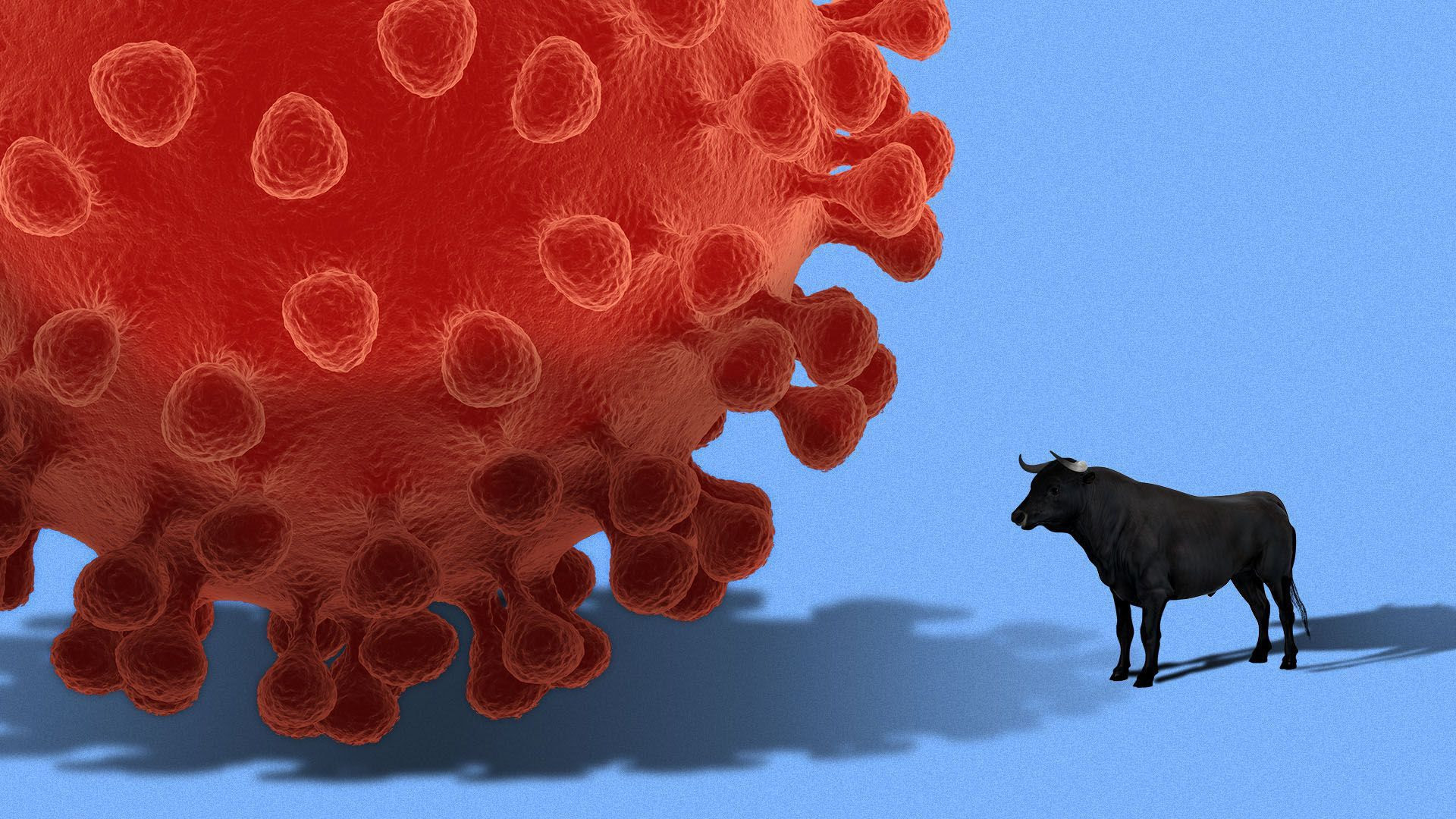| | | | | | | | | | | Axios Future | | By Bryan Walsh ·Jan 09, 2021 | | Welcome to Axios Future, where we just finished one of those weeks when decades happen. Today's Smart Brevity count: 1866 words or about 7 minutes. | | | | | | 1 big thing: The uncertain future of human reproduction |  | | | Illustration: Sarah Grillo/Axios | | | | As the U.S. fertility rate falls to a 35-year-low, new technologies promise to radically change how we have babies. Why it matters: The demand for assisted reproductive technology like IVF is likely to grow as people delay the decision to have children. But newer advances in gene editing and diagnostic testing could open the door for a revolution in reproduction, raising ethical questions we haven't begun to answer. By the numbers: New data from the CDC indicates the U.S. had just 58.2 births per 1,000 women aged 15 to 44 in 2019, a 1% decline from the previous year and the lowest level since 1984. Between the lines: The one age group in the U.S. where births are increasing is among women over 40, a factor of both delayed marriage and cohabitation and improved fertility technology. - From 2009 to 2017, the total number of assisted reproductive technology (ART) cycles increased by more than 8% a year on average.
- But as more prospective mothers are turning to IVF, the technology is still far from perfect, with live births per IVF cycle actually declining in recent years.
What's happening: New technologies and practices offer some hope for improving IVF in the near future. - Researchers tried to train an AI algorithm to identify the quality of embryos and found the model could differentiate between high- and low-quality embryos with about 97% accuracy — higher than most fertility professionals.
- That could help prevent clinics from attempting to implant embryos that are likely to fail.
What's next: IVF is already more than 40 years old, but the next stage of reproductive technology is likely to be even bigger — and even more ethically complex. - Prospective parents can already employ preimplantation genetic testing (PGD) to screen IVF-created embryos for hundreds of possible genetic abnormalities. But as both genetic sequencing technology and our knowledge of the genome improves, it's possible parents will be able to screen embryos with far more detail, including for intelligence and even cosmetic traits.
- As long as IVF remains expensive and uncomfortable, there will be natural limits to its use. But in his fascinating book "The End of Sex," the bioethicist Hank Greely projects a near-future of what he calls "easy PGD," where artificial reproduction — including the ability to screen and select the "best" embryos — essentially displaces making babies the old-fashioned way.
- As stem cell science improves, skin cells could be reprogrammed to become egg or sperm cells, potentially allowing parents to create thousands or even millions of embryos, and choose the one they want.
- In such a future, LGBT couples could produce children who share the genes of both partners, and single parents could create a child on their own, by generating both the egg and sperm cells from their own bodies.
Of note: As gene editing improves, parents of the future may not even need to screen and pick embryos, instead writing in the genetic profile they desire. The catch: This technology doesn't exist for humans yet, and any effort to purposefully edit human embryos for "desirable" traits depends on far greater knowledge of the human genome than scientists currently possess — and raises enormous ethical questions. The bottom line: In the future, prospective parents will have a bewildering array of new ways to have children. |     | | | | | | 2. Visiting the IVF clinic of tomorrow |  | | | TMRW's automated frozen emrbryo tracking system. Photo: Bryan Walsh | | | | TMRW Life Sciences is bringing automation to the surprisingly analog world of storing and tracking frozen eggs and embryos for IVF. Why it matters: Clinics are struggling to keep track of embryos that might be stored for months or even years. A more modern system can cut down on clinic errors and improve overall success rates. Background: More than 4,000 frozen eggs and embryos were lost at University Hospitals in Cleveland in 2018 after a freezer failed and an alarm that would have alerted clinic staffers was off. - Although there is no national system for tracking accidents in reproductive clinics, such failures are hardly unheard of.
- The technology used in most clinics was originally developed in the 1960s for livestock breeding, and cryopreservation containers aren't regulated any better than standard kitchen appliances.
- "IVF clinics have become inadvertent bio-repositories, and they've simply been crushed by it," says Joshua Abram, TMRW's co-CEO.
How it works: TMRW has created an integrated hardware and software solution that tracks individual eggs and embryos with RFID tags, to ensure the chain of custody of tissue is never broken. - Its automated platform — which I had a chance to view during a recent visit to TMRW's showcase display in New York's SoHo district — allows for samples to be audited via a computer, without removing eggs or embryos from deep freeze, which ensures they remain at the optimal temperature.
- Its cloud-based monitoring system can check the samples' environment thousands of times per day, while machine learning can proactively alert clinic staff before any problems occur — ideally preventing the kind of catastrophe that occurred in Cleveland.
What they're saying: "We are the operating system for how a couple hundred million people are going to be conceived," says Abram. "Its completely digital and everything you'd expect in a 21st century system." What's next: TMRW will be launching commercially in a number of IVF clinics at the end of the month, with plans to expand into Europe. |     | | | | | | 3. Making protein out of thin air |  | | | Illustration: Annelise Capossela/Axios | | | | A startup is working on technology that produces protein from the elements found in air. Why it matters: The world will struggle to feed billions more people by mid-century without clearing more land for farming or livestock. Being able to generate nutritious protein with little more than energy and air could open the door to sustainable vertical farms. What's happening: On Thursday the startup Air Protein pulled in $32 million in a Series A fundraising round led by the corporate venture capital arm of ag giant Archer Daniels Midland. How it works: Air Protein takes the basic elements in air — carbon dioxide, oxygen and nitrogen — and combines them with water and minerals, before using renewable energy and probiotics in fermentation vessels to yield amino acids. - "We end up with a flour that is rich in proteins, vitamins and minerals," says Lisa Dyson, a physicist and the founder and CEO of Air Protein.
- Those amino acids can then be sculpted using pressure and temperature to gain the same flavor and texture as meat, she adds.
Details: Unlike conventional livestock raising — which now takes up more than a quarter of the planet's terrestrial surface — Air Protein's technology doesn't require arable land and can be "deployed anywhere in any climate," says Dyson. "This is massively scalable." But, but, but: While other players in the alternative protein sector are already selling to consumers or at least operating pilot plants, Air Protein's technology is still in the earliest stages. The bottom line: There's no such thing as a free lunch, but being able to make protein out of thin air would be pretty close. Go deeper: Meat grown from cells moves out of the lab |     | | | | | | A message from Axios | | How to navigate COVID-19's impact on the markets | | |  | | | Axios markets editor Dion Rabouin provides the latest economic news and crucial insights every weekday in Axios Markets. - In turbulent times, Dion puts a sharp lens on the shifting worlds of global.
Subscribe for free | | | | | | 4. 2020 ties 2016 as warmest year on record |  | | | Bidwell Bar Bridge surrounded by fire during the Bear Fire in Oroville, California, on Sept. 9, 2020. Photo: Josh Edelson/AFP via Getty Images | | | | Last year tied 2016 as the warmest year ever recorded, capping the end of the warmest decade on record as well, per data released Friday by the EU's Copernicus Climate Change Service, my Axios colleague Ben Geman and I write. By the numbers: "2020 was 0.6°C warmer than the standard 1981-2010 reference period and around 1.25°C above the 1850-1900 pre-industrial period," Copernicus said in a summary of its data. - The last six years are the six warmest on record, according to Copernicus.
Threat level: "It is notable that 2020 matches the 2016 record despite a cooling La Niña, whereas 2016 was a record year that began with a strong warming El Niño event," Copernicus said. The big picture: The EU data arrives as the world is nowhere near on track for the steep emissions cuts that would be consistent with the aims of the Paris climate agreement. - "[T]he world is still heading for a temperature rise in excess of 3°C this century — far beyond the Paris Agreement goals of limiting global warming to well below 2°C and pursuing 1.5°C," a major UN analysis found last month.
Of note: NOAA announced on Friday that the U.S. experienced a record-breaking 22 separate billion-dollar weather and climate disasters in 2020. - The total cost of all disasters experienced last year — which ranged from hurricanes in the Gulf to wildfires in the West — exceeded $1.875 trillion.
- And it could have been worse — while the U.S. was hit by 12 named storms, the most in 104 years, they mostly missed major population centers.
Yes, but: As the climate scientist Roger Pielke Jr. pointed out on Twitter, economic growth means that a billion dollars isn't what it used to be. - Weather losses as a percentage of U.S. GDP have generally declined over the past 30 years.
|     | | | | | | 5. Worthy of your time | | Why those who care about catastrophic and existential risk should care about autonomous weapons (Anthony Aguirre — Effective Altruism) - A wonky but smart post on the potentially disastrous long-term effects of more-advanced autonomous weapons that can operate without human intervention.
How COVID laid bare America's economic and political divides (Stephanie Flanders and Lucy Meakin — Bloomberg) - A devastating podcast segment on how COVID-19 has worsened what I have come to believe is America's defining issue: inequality.
The people who want to send smells through your TV (Mark Ellwood — BBC Future) - The reason why Smellovision has yet to take off: we don't really understand the complex human sense of smell.
The sperm kings have a problem: too much demand (Nellie Bowles — New York Times) - More than you have ever, ever, ever wanted to know about the world of sperm donation and the impact of COVID-19 on America's overworked donors.
|     | | | | | | 6. 1 worrying thing: Cracks in nuclear command and control |  | | | An atomic bomb test in Nevada in 1957. Photo: © CORBIS/Corbis via Getty Images | | | | House Speaker Nancy Pelosi said in a letter to members on Friday that she's spoken to the Joint Chiefs of Staff Chairman Mark Milley about preventing President Trump from accessing the nuclear codes. Why it matters: Pelosi's message surfaced an uncomfortable reality about America's nuclear control structure: if the president wants to use nukes, there is no clear way to stop him. What's happening: In her message, Pelosi mentioned discussing "available precautions" around Trump and the nuclear codes. Reality check: Such precautions do not exist. Be smart: For all the destructive power of nuclear weapons, a different factor dictates America's command and control structure: their speed. - Absolute presidential control of the nuclear arsenal was solidified in part out of the realization that the speed of nuclear war would not allow for lengthy debates.
- If a U.S. president were alerted that ICBMs were inbound from Russia, there might be as few as 10 minutes to decide whether to retaliate before the missiles reached their destination.
- That time pressure doesn't exist in the case of an American first use of nuclear weapons. But as an unprecedented Senate hearing in 2017 made clear, while protocol calls for the president to consult with several officers and officials before launching nuclear weapons, "the president has no obligation to take the officers' advice," Kaplan wrote.
Flashback: President Obama reportedly weighed ruling out first use of nuclear weapons in a conflict, but never went through with it. - Sen. Edward Markey drafted a bill in 2019 blocking the president from launching a first strike without congressional consent, but it never went to a vote.
The bottom line: The power to use the most devastating weapons ever devised rests in the president's hands. |     | | | | | | A message from Axios | | How to navigate COVID-19's impact on the markets | | |  | | | Axios markets editor Dion Rabouin provides the latest economic news and crucial insights every weekday in Axios Markets. - In turbulent times, Dion puts a sharp lens on the shifting worlds of global.
Subscribe for free | | | | | | Axios thanks our partners for supporting our newsletters.
Sponsorship has no influence on editorial content. Axios, 3100 Clarendon Blvd, Suite 1300, Arlington VA 22201 | | | You received this email because you signed up for newsletters from Axios.
Change your preferences or unsubscribe here. | | | Was this email forwarded to you?
Sign up now to get Axios in your inbox. | | | | Follow Axios on social media:    | | | | | |









No comments:
Post a Comment